
Chilling cockpit recordings have emerged detailing a heart-stopping aviation emergency over Boston, where pilots from two major airlines worked frantically to bring a stricken aircraft safely to ground at Logan International Airport.
The Moment Crisis Struck
The dramatic audio reveals the tense communication between Delta Air Lines and Cape Air pilots after one aircraft experienced a severe flight control malfunction. The recordings capture professional but urgent exchanges as the crews coordinated their emergency response high above the Massachusetts coastline.
"We've got a situation here," one pilot can be heard stating calmly but firmly, setting in motion a carefully choreographed emergency procedure that would test both crews' training and composure.
Expert Coordination in Critical Moments
Air traffic controllers at Boston Logan immediately sprang into action, clearing airspace and prioritising the distressed aircraft's landing path. The audio demonstrates remarkable professionalism as both flight crews maintained clear communication despite the high-pressure situation.
What makes this incident particularly noteworthy is the seamless cooperation between major carrier Delta and regional operator Cape Air, showcasing the aviation industry's robust safety protocols in action.
Emergency Protocols Activated
Investigators confirmed that all emergency procedures were followed correctly, with airport emergency services placed on high alert as the aircraft made its final approach. The nature of the flight control issue remains under investigation by aviation authorities.
Passengers reported feeling sudden vibrations and unusual aircraft movements before the captain announced the need for an emergency landing. "The crew remained incredibly professional throughout," one passenger later commented.
Safety Systems Prove Effective
This incident highlights the multiple layers of safety built into modern aviation. From redundant flight control systems to extensive pilot training and ground support, every element worked as designed to ensure a safe outcome.
Aviation experts have praised both flight crews for their handling of the situation. "This is exactly how these scenarios are supposed to unfold," said former pilot and safety analyst Michael Henderson. "The training kicked in, the communication was perfect, and the result was a textbook emergency landing."
The successful resolution of this airborne emergency serves as a powerful reminder of the aviation industry's commitment to passenger safety, even when facing unexpected technical challenges at 30,000 feet.





